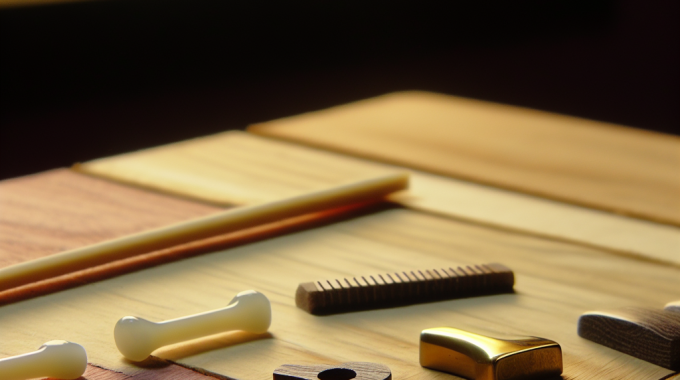Ukulele nut and saddle materials play a crucial role in the overall performance and sound quality of the instrument. The nut and saddle are two small, yet essential, components that directly impact the tone, sustain, and intonation of the ukulele. The materials used for these parts can vary from traditional bone and ivory to more modern synthetic materials like TUSQ and Micarta. The choice of nut and saddle materials can greatly influence the playability and overall sound of the ukulele, making it a critical consideration for both manufacturers and players.
One of the primary issues faced with ukulele nut and saddle materials is finding the right balance between durability and tone. Traditional materials like bone and ivory may provide superior tonal qualities but are more susceptible to wear and tear over time. On the other hand, synthetic materials are often more durable but may not offer the same level of tonal richness. Additionally, different materials can also affect the playability and intonation of the instrument, further complicating the decision-making process for players and manufacturers. As a result, there is a growing interest in exploring the various options available for ukulele nut and saddle materials and their impact on the instrument’s sound and performance. This review will delve into the different types of materials used for ukulele nuts and saddles, their pros and cons, and how they ultimately contribute to the overall playing experience.
Function
The Ukulele nut and saddle serve as crucial components in transmitting the vibrations of the strings to the instrument’s body, thus affecting the overall sound and tone produced. The nut is responsible for setting the string height at the headstock, while the saddle sets the string height at the bridge. Both materials play a significant role in determining the instrument’s playability and sound quality.
Uses
The materials used for Ukulele nut and saddle construction should possess excellent transmission of string vibrations, as well as durability to withstand constant string tension. Commonly used materials include bone, synthetic bone, plastic, and various types of wood. Each material offers distinct characteristics, affecting the instrument’s tone and performance.
Design
When it comes to design, the nut and saddle must be precisely shaped and slotted to accommodate the ukulele’s specific string gauges. Additionally, the material’s density and hardness need to be considered to ensure proper fret clearance and string vibration transmission. The design of these components ultimately affects the overall action and intonation of the instrument.
Build Quality
The build quality of Ukulele nut and saddle materials is paramount to ensure longevity and consistent performance. High-quality materials with precise manufacturing and fitting are essential to prevent premature wear or buzzing while maintaining stable tuning and intonation.
Primary Features
Different materials offer distinct features that impact the instrument’s performance. For instance, bone provides excellent transference of string vibration and sustain, while synthetic materials like Tusq offer consistent density and improved harmonics. Understanding these primary features is essential in selecting the appropriate nut and saddle materials for a particular ukulele model.
Recommended Ukulele nut and saddle materials
| Ukulele Nut Materials | Pros | Cons |
|---|---|---|
| Bone | Renders a clear and vibrant tone | May be more expensive than other materials |
| Plastic | Cost-effective and readily available | Can dampen the sound quality |
| Graphite | Allows for smooth tuning stability | May lack the warmth of other materials |
| Ukulele Saddle Materials | Pros | Cons |
|---|---|---|
| Bone | Enhances sustain and overall tone | May require additional maintenance |
| Tusq | Offers consistent and balanced tone | May not provide the same warmth as bone |
| Plastic | Durable and affordable option | Can potentially dull the sound |
Top 10 rated Ukulele nut and saddle materials
Materials
When it comes to choosing the right nut and saddle materials for your ukulele, there are a few factors to consider. The most common materials used for nuts and saddles are plastic, bone, and synthetic materials such as Tusq or Corian. Each material has its own unique characteristics that can affect the sound and playability of your instrument.
Plastic is the most affordable option, but it may not provide the best tone or sustain. Bone is a popular choice for many musicians due to its excellent tone and durability. Synthetic materials like Tusq and Corian are also worth considering, as they can offer a good balance of tone and durability.
When evaluating different nut and saddle materials, it’s important to consider the type of sound you want from your ukulele and the level of durability you need. Keep in mind that the nut and saddle can have a significant impact on the overall tone and playability of your instrument, so choose wisely.
Fit and Compatibility
Another important factor to consider when choosing nut and saddle materials is the fit and compatibility with your ukulele. Not all materials will work well with every ukulele, so it’s essential to ensure that the nut and saddle are the right size and shape for your instrument.
When shopping for nut and saddle materials, be sure to check the specifications and measurements to ensure a proper fit. Some nuts and saddles may require slight modifications to fit your ukulele, so it’s important to factor in any additional work that may be needed.
In addition to fit, it’s also important to consider the compatibility of the materials with other components of your ukulele. For example, some materials may work better with certain types of strings or bridge designs. Be sure to do your research and consult with a professional if you’re unsure about compatibility.
Price and Value
Price is always a consideration when making a purchase, and nut and saddle materials are no exception. While it’s important to stay within your budget, it’s also crucial to consider the overall value of the materials you’re purchasing.
Keep in mind that higher-quality materials may come at a higher price, but they can also offer better tone and durability. On the other hand, cheaper materials may save you money upfront, but they may not provide the best sound or longevity.
When evaluating the price and value of nut and saddle materials, consider the long-term benefits of investing in higher-quality materials. It may be worth spending a bit more upfront to ensure that your ukulele sounds and plays its best for years to come.
Brand and Reputation
When shopping for nut and saddle materials, it’s important to consider the brand and reputation of the manufacturer. Some brands are known for producing high-quality, reliable materials, while others may have a less favorable reputation.
Do your research and look for reviews and testimonials from other musicians who have used the materials you’re considering. Consider the brand’s track record for consistency and customer satisfaction, as this can be a good indicator of the quality you can expect.
In addition to brand reputation, it’s also important to consider the level of customer support and warranty offered by the manufacturer. A reputable brand will stand behind their products and provide excellent customer service in the event of any issues.
Conclusion
Choosing the right nut and saddle materials for your ukulele is an important decision that can have a significant impact on the instrument’s sound and playability. Consider factors such as materials, fit and compatibility, price and value, and brand reputation when evaluating your options.
With a bit of research and consideration, you can make an informed purchase decision that will ensure your ukulele sounds its best and plays beautifully for years to come. Whether you prefer the warm tone of bone or the durability of synthetic materials, there are plenty of options available to suit your needs and preferences.
Best choice for Ukulele nut and saddle materials in 2024
Finding the Right Ukulele Nut and Saddle Materials on Amazon
When looking for the right ukulele nut and saddle materials on Amazon, there are a few key factors to consider. Here are some tips to help you find the perfect options for your ukulele:
Consider the Material
There are various materials used for ukulele nuts and saddles, including bone, synthetic bone, plastic, and graphite. Each material has its own unique properties that can affect the tone and sustain of your ukulele. Bone and synthetic bone are popular choices for their ability to transfer vibration, while plastic and graphite can be more affordable options.
Read Customer Reviews
Take the time to read customer reviews to see what others are saying about the ukulele nut and saddle materials you are considering. Look for feedback on the tone, durability, and overall quality of the materials to help you make an informed decision.
Check for Compatibility
Make sure the nut and saddle materials you are considering are compatible with your specific ukulele model. Some materials may require slight modifications to fit properly, so be sure to double-check the product details and dimensions before making a purchase.
Common Issues with Ukulele Nut and Saddle Materials
One common issue related to ukulele nut and saddle materials is the potential for poor tone and sustain if the wrong materials are chosen. It’s important to carefully consider the material and its impact on the overall sound of your ukulele.
Another issue to be aware of is the potential for poor fit and compatibility. If the nut and saddle materials are not the right size or shape for your ukulele, it can lead to buzzing, intonation problems, and difficulty playing.
Cheapest alternatives for Ukulele nut and saddle materials
Frequently Asked Questions
What are the different types of materials used for ukulele nuts and saddles?
There are several materials commonly used for ukulele nut and saddle construction, including bone, plastic, graphite, and various types of metal. Each material has its own unique properties and can affect the tone and playability of the ukulele.
Which material is best for ukulele nuts and saddles?
The best material for ukulele nuts and saddles can depend on personal preference and the specific qualities you are looking for in your instrument. Bone is often preferred for its natural tone and sustain, while synthetic materials like graphite can provide a more consistent tone and performance over time.
Do different materials affect the sound of a ukulele?
Yes, the material of the nut and saddle can have a noticeable impact on the tone and sustain of a ukulele. Bone and synthetic materials tend to provide a clear and sustained sound, while plastic may produce a slightly duller tone.
How often should I replace the nut and saddle on my ukulele?
The frequency of nut and saddle replacement can depend on how often the ukulele is played and the specific material used. In general, bone and synthetic materials tend to last longer than plastic and may not need replacement as frequently.
In conclusion, the choice of nut and saddle materials for your ukulele is a crucial factor in determining the instrument’s tone and playability. After reviewing various materials such as bone, synthetic, and brass, it is evident that each has its own unique benefits. Bone offers excellent sustain and clarity, synthetic materials are affordable and durable, and brass provides a bright and punchy tone.
Ultimately, the value of selecting the right nut and saddle materials lies in the enhancement of the overall sound and performance of your ukulele. Whether you prioritize rich tonal quality, longevity, or a specific aesthetic, choosing the right materials can greatly impact your playing experience. By carefully considering the benefits of each material, you can make an informed decision that enhances your ukulele’s playability and sound quality.

